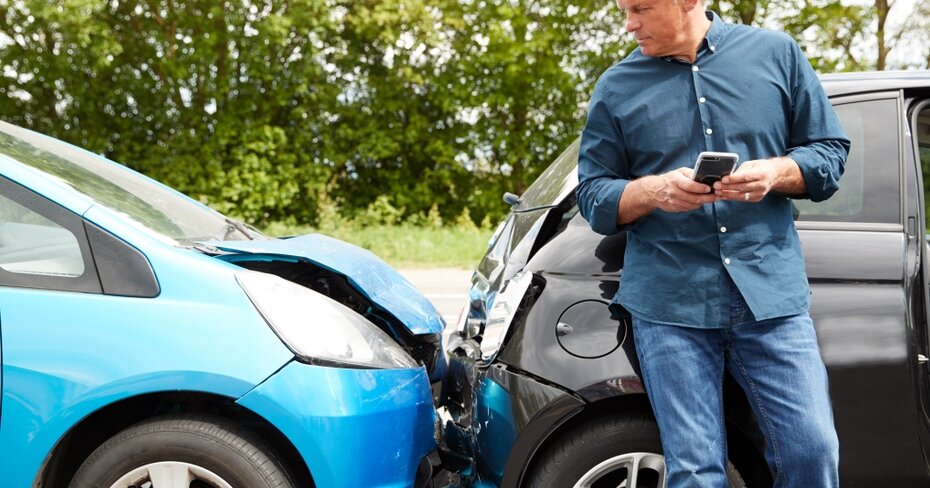How do you determine who’s at fault in a car accident?
By: Alexandra Bosanac on July 3, 2025
This article has been updated from a previous version.
In Canada, assigning fault in car accidents is a meticulous process, and it can have significant implications on insurance premiums and claims.
Several years ago, I was in a collision that left me dumbfounded.
It happened in a condo building’s visitor parking lot. I was backing out of my spot, and a woman who had parked in the space directly in front of mine was pulling out, as well.
My back bumper and her front bumper hit each other. That’s actually an exaggeration. They kissed, briefly.
That’s all that happened. There was no noticeable damage done to either car.
Pretty anti-climactic, right? Not according to the other driver, who was outraged. It turned out that she was driving a rental car without insurance.
At the time, I didn’t have my full license yet and I felt unprepared and overwhelmed by the accident. I apologized profusely and we exchanged phone numbers.
Traditionally, the person who rear-ends another car is found responsible. But we were both leaving our parking spaces at exactly the same time. Our impeccable timing was both impressive and confusing — how would an insurance adjuster figure out who was responsible?
Plus, I was worried that an insurance company would take the word of an older, more experienced driver over someone young with only a learner’s permit.
In this article:
What does “at fault” mean?
The term "at fault" refers to the party or parties responsible for causing the accident. When an individual is deemed "at fault" for an accident, it means that their actions, negligence, or failure to adhere to traffic laws and regulations played a significant role in the collision.
Understanding fault allocation is critical, as it directly impacts insurance claims, liability, and the potential legal consequences following an accident.
Factors that affect fault allocation
Determining fault in a car accident is a multifaceted process, requiring a comprehensive assessment of several critical factors.
Traffic laws
Traffic laws and regulations serve as the foundation for assigning fault. Insurance adjusters often turn to the specific traffic laws applicable in the region where the accident occurred. Violations, such as running a red light or failing to yield the right-of-way, significantly impact the likelihood of being found at fault.
Road and weather conditions
The condition of the road at the time of the accident is also crucial to determining fault. Poor road conditions, such as ice, rain, or debris, can affect a driver's ability to maintain control of their vehicle. Drivers are expected to adjust their driving to match these conditions, and failing to do so can influence fault assignment. For example, to combat icy Canadian roads, equip your vehicle with winter tires.
Role of witness statements
Independent witnesses who observed the accident can provide invaluable insights into the events leading up to the collision. Insurance adjusters rely on witness statements to corroborate or challenge the drivers' accounts and, in doing so, form a more comprehensive understanding of the incident.
Comparative negligence
In some cases, both parties involved in the accident may share responsibility. Insurance adjusters use the concept of comparative negligence to determine each party's degree of fault. This means that fault is allocated based on the level of responsibility of each party, often resulting in a percentage assignment of blame.
Dashboard cameras and video footage
The presence of dashboard cameras, and footage from surveillance cameras in the vicinity, like store security cameras and traffic cameras, can provide valuable evidence to help adjusters determine fault. These video recordings can offer unbiased accounts of the accident's sequence.
Black box collision data
Modern vehicles often come equipped with event data recorders (EDRs), commonly referred to as "black boxes." These devices capture rich data regarding vehicle speed, braking, and other parameters at the time of the accident, offering insights into the collision's dynamics.
Medical data
If a person involved in the accident sustains injuries, their medical data can be relevant in assessing fault. This includes information on the extent of injuries, the medical treatment received, and any pre-existing conditions that may have influenced the accident's outcome.
Assigning blame is a science
Insurance adjusters employ a precise approach to determine fault in car accidents. Contrary to my actions during that accident, it's essential not to admit fault. This is because admissions of guilt can complicate the claims process and potentially affect the final resolution.
Insurance adjusters use a percentage system to assign blame. If multiple parties share responsibility, the blame is divided evenly, leading to increased insurance premiums for all parties involved. However, reaching a mutual agreement on what transpired is crucial.
How you report an accident matters, too. Using the correct terminology, especially in parking lot collisions, helps paint a clearer picture of the event to adjusters. For example, if you’re in a mall parking lot, detailing whether you were in the “feeder lane” when a car in the “thoroughfare” struck you can make a difference. Using precise language can help the adjuster take your account more seriously.
Related: How long do you have to report an accident to your insurance company in Ontario?
How is fault determined?
In Canada, guidelines for apportioning fault can vary by province. For instance, the Financial Services Commission of Ontario (FSCO) sets the parameters in Ontario. In other regions, self-regulating organizations within the insurance industry establish these rules. In cases of severe collisions where police are called in, insurance adjusters refer to police reports when determining fault.
“There can be situations that are very complex, where they [insurance adjusters] have to do some PI work to apply fault fairly,” says Rebekah Schinkel, vice president of operations at HUB International.
Insurance companies rely on certain common principles
Considering how nuanced the fault determination process is, being found zero per cent at fault is exceptionally rare, and only really comes up in a handful of very specific instances.
For example, rear-ending another car often results in 100 per cent culpability. I
“You need to be travelling with an accurate amount of space between you and the person ahead of you in case you need to brake. That’s the responsibility of the driver behind,” says Schinkel.
Even in single-vehicle accidents, the driver usually carries the burden of responsibility. Unforeseen factors like black ice on the road may be considered, but drivers are expected to take necessary precautions.
“The easiest way to explain it is you can’t blame the road, the guard rail [or] the deer if yours is the only car involved,” says Schinkel. “In general, that falls on you as the driver to take the necessary steps to prevent the accident.”
She adds, “If there’s black ice on the road and you slam into the guardrail, yes there was ice, but you should have been driving [in such a way] that you would avoid that.”
Other than the examples above, Schinkel can only think of one person in her entire career who was eventually found zero per cent at fault by their insurer.
“The dash cam showed that the person [in another car] reversed into them. They submitted the tape to their adjuster and established themselves as zero per cent at fault,” she recalls.
But the standard of proof needed in order for a driver to be found completely blameless is pretty specific. In cases where the facts are hard to establish, insurance adjusters are more likely to decide that blame should be split 50/50.
“Twenty-five or 75 per cent are quite rare,” says Schinkel.
Related: Think you’re safe? What every Canadian needs to know about impaired driving
Impact of fault on your insurance rate
If you are found partially at fault for an accident, the immediate impact on your insurance rate is minimal — but it may increase at your next renewal.
“Nothing happens until renewal. Your rate is your rate until the next renewal,” says Adam Mitchell, insurance broker and CEO of Whitby, Ont.-based brokerage Mitch Insurance. You may not even see an increase at all, depending on your policy.
“If you bought accident insurance beforehand, it would actually have zero impact. It will renew at the same calculated rate,” he adds.
Without accident coverage (which typically costs an additional $100 per year), your rate can surge by as much as 20 per cent.
However, getting accident insurance, also known as an accident forgiveness endorsement, can be challenging. It depends on your driving history and the number of years you've been accident-free.
Related: What is an insurance endorsement or rider?
It’s also based on a star system
One star is awarded every year you’ve been accident-free. A new driver starts with a 0-star rating. Following a year of accident-free driving, they will advance to a 1-star rating. In the following year, provided they maintain their accident-free record, they will progress to a 2-star rating.
“A six-star rating is a perfect record,” says Mitchell. That means you’ve been driving for six years or more and have been completely accident-free.
“If you did have an accident, you’d go to a five-star,” he adds. “You don’t go down to a zero automatically.”
Read more: Do different types of collisions impact your car insurance rates?
Seek advice before filing a claim
If you’re unsure about your level or percentage of fault, consider consulting with a claims counsellor before talking to your insurance company.
Some insurance carriers offer claims counselling, but this service is traditionally offered by brokers. Conversations with claims counsellors are confidential, and they’ll advise you on whether it’s in your best interest to file a claim.
“Our primary interest is what is in the best interest of the client,” says Schinkel. “We are not obligated to pass it on to the insurance company.”
Being found at-fault in an accident can have long-term impacts as well. Switching insurance companies can be tricky, for example, or you might lose your accumulated accident-free years and have to start from scratch. It’s worth thinking twice before making a switch.
Related: What to do after a collision, and how to file an insurance claim
The parking lot exemption
As for the final verdict on the collision I was involved in? If there had been any damage, I probably would have been 50 per cent at fault.
“When it comes to parking lots, it’s almost always joint-fault unless your car is in a parked position or turned off during the incident,” says Schinkel. “If it’s not even running and it hit you, and you weren’t in motion, it’s clearly not your fault. If both vehicles are in motion, both parties are almost always in the wrong.”
Good thing I didn’t leave a scratch.
Read next: How traffic convictions and collisions impact your auto insurance rate
Save 23% on average on car insurance
Compare 50+ quotes from Canadian providers in 3 minutes.


